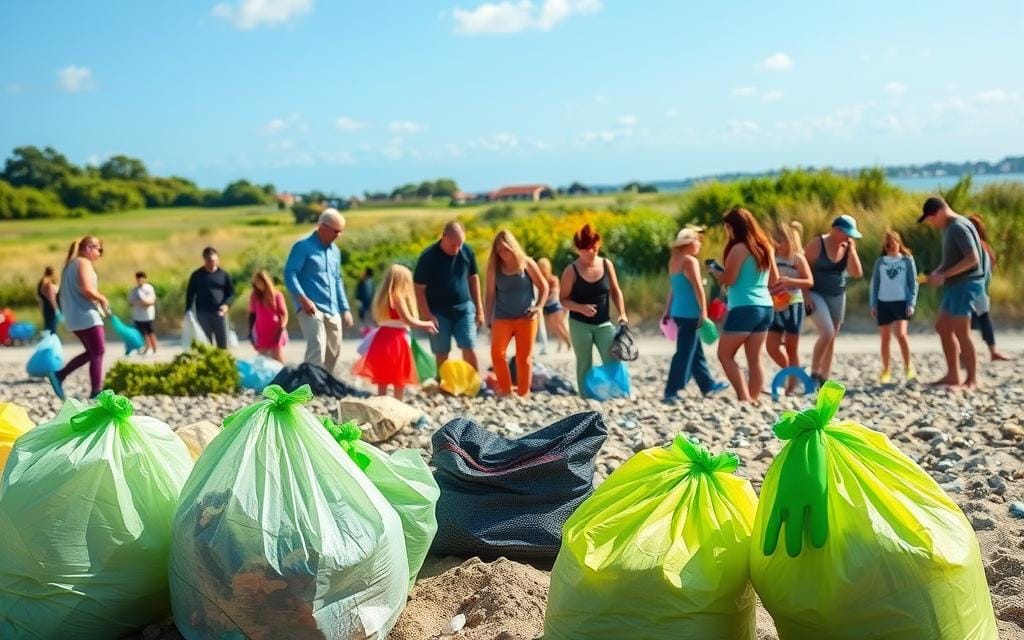Learn how to organize a local beach or park cleanup. Get tips on gathering volunteers, planning logistics, and making a positive impact on the environment.
Have you ever wondered how much of an impact a single cleanup event can have on your community and the environment? Every year, tons of debris wash up on our coasts, threatening marine life and local tourism. A well-planned cleanup can make a significant difference.
Cleanups not only protect our waters but also bring people together. Volunteers play a crucial role in these events, helping to remove trash and restore natural beauty. With the right supplies and a dedicated team, we can create a cleaner, healthier environment for everyone.
In this guide, we’ll walk you through the steps to plan a successful cleanup. From gathering supplies to documenting results, every detail matters. Let’s work together to make our beaches and parks cleaner and safer for future generations.
Table of Contents
TogglePlanning Your Cleanup Event
Planning a cleanup event requires careful preparation to ensure success. A well-organized effort starts with selecting the right location, securing necessary permits, and gathering essential supplies. These steps lay the foundation for a smooth and impactful event.
Identifying the Ideal Cleanup Location
Choose a park or area that needs attention. Look for places with visible waste or high foot traffic. Visit the site in advance to assess the scope of work and identify potential challenges. This step ensures you’re prepared for the day of the event.
Securing Permits and Approvals
Contact local authorities to secure permits for your cleanup. Explain your plan and ensure compliance with regulations. Permits may be required for waste disposal or using public spaces. This step prevents legal issues and ensures a smooth process.
Gathering Essential Supplies and Tools
Prepare a list of supplies needed for the cleanup. Essential items include trash bags, gloves, and first-aid kits. Here’s a breakdown of what you’ll need:
| Item | Quantity | Purpose |
|---|---|---|
| Trash Bags | 50 | Collect waste |
| Gloves | 30 pairs | Protect hands |
| First-Aid Kits | 2 | Handle minor injuries |
| Reusable Water Bottles | 20 | Stay hydrated |
Use social media to announce the event and recruit volunteers. Share updates and encourage others to join. A well-planned cleanup event not only improves the environment but also strengthens community bonds.
How to Organize a Local Beach or Park Cleanup
Every cleanup event starts with a vision and measurable objectives. Defining clear goals ensures your efforts make a lasting impact. Whether it’s removing debris or protecting marine life, a well-planned event can transform your community.
Defining Your Goals and Expected Impact
Start by setting specific outcomes for your cleanup. For example, aim to collect a certain number of pounds of trash or clear a specific area. Measurable goals help guide volunteer assignments and track progress.
Consider the broader impact of your event. According to EcoWatch, beach debris significantly harms marine life. By removing trash, you’re not just cleaning a park—you’re protecting ecosystems and improving water quality.
Communicate these objectives during pre-event briefings. Clear goals keep everyone focused and motivated. Tracking data, such as the amount of debris collected, also highlights the event’s success.

Recruiting Volunteers and Partnering with Local Organizations
Building a dedicated team is essential for a successful cleanup. Use social media and community networks to recruit volunteers. Share your vision and inspire others to join the effort.
Partnering with local organizations can amplify your impact. Many groups, like environmental nonprofits, already host cleanups and can provide resources or expertise. Collaborations strengthen community bonds and ensure a well-organized event.
Highlight the value of teamwork during recruitment. A united effort not only cleans up trash but also fosters a sense of pride and ownership in the community.
By setting clear goals and building strong partnerships, your cleanup event can achieve meaningful results. Together, we can create cleaner, healthier spaces for everyone to enjoy.
Engaging Your Community and Volunteers
Engaging the community is key to a successful cleanup event. A strong volunteer base ensures the effort is impactful and sustainable. By involving diverse groups, we create a shared sense of responsibility for our environment.
Utilizing Social Media and Local Advertising
Social media is a powerful tool for spreading the word. Platforms like Facebook and Instagram allow us to share updates, photos, and event details. Encourage followers to invite friends and family to join the effort.
Local media outlets can also amplify your message. Reach out to newspapers, radio stations, and community blogs. Highlight the event’s goals and the positive impact it will have on the area.

Collaborating with Local Businesses and Vendors
Partnering with local businesses can provide essential resources. Many vendors are willing to donate supplies like trash bags, gloves, or refreshments. In return, offer them recognition during the event and in promotional materials.
Collaborations also bring added publicity. Businesses often share event details with their customers, expanding your reach. This mutual support strengthens community ties and ensures a successful cleanup.
Clear communication is vital for keeping everyone informed and safe. Assign specific roles to volunteers, such as waste collection or data recording. Here’s a breakdown of common responsibilities:
| Role | Responsibilities |
|---|---|
| Team Leader | Oversee tasks and ensure safety |
| Waste Collector | Gather trash and sort recyclables |
| Data Recorder | Track the amount and type of waste collected |
| Refreshment Coordinator | Distribute water and snacks |
By engaging the community and fostering partnerships, we create a cleaner, healthier environment. Together, we can make a lasting difference.
Managing the Day of the Cleanup
The day of the cleanup is where all the planning comes to life, and effective management ensures success. From coordinating volunteers to handling waste, every detail matters. A well-organized effort maximizes impact and keeps everyone safe.
Coordinating Volunteer Assignments and Safety Protocols
Start by assigning specific zones and tasks to your team. Divide the area into sections to ensure full coverage. This approach helps volunteers focus and work efficiently.
Safety is a top priority. Provide gloves and first-aid kits to all participants. Brief everyone on handling hazardous debris, such as broken glass or sharp objects. Clear instructions prevent accidents and ensure a smooth process.
Implementing Waste Removal and Data Collection Strategies
Set up designated stations for waste sorting. Separate recyclables from general trash to promote sustainability. Proper disposal methods protect the environment and comply with local regulations.
Data collection is crucial for measuring success. Assign volunteers to record the amount and type of waste collected. This information highlights the event’s impact and can be shared with the community.
Documenting the Event with Photos and Reports
Capture the effort with photos and videos. Visuals showcase the team’s hard work and inspire future participation. Share these images on social media to spread awareness.
Write a detailed report summarizing the event. Include key metrics, such as the amount of trash collected and the number of volunteers. This documentation serves as a record of your community’s commitment to a cleaner environment.
By managing the day effectively, we ensure a successful and impactful cleanup. Together, we can make a lasting difference in our parks and communities.
Conclusion
Taking action to clean our shared spaces can transform communities and protect ecosystems. A successful cleanup event starts with careful planning, engaging volunteers, and managing the day efficiently. By securing permits, recruiting a dedicated team, and using tools like trash bags and gloves, we ensure a smooth process.
These efforts protect marine life, improve water quality, and enhance local parks. Social media and partnerships amplify our impact, while photos and data highlight the results. Make sure safety and proper waste disposal remain top priorities throughout the event.
Together, we can create cleaner, healthier spaces for everyone. Take ownership of your community and plan your own cleanup. Share your experiences and inspire others to join the effort. Every piece of trash removed is a step toward a brighter future for our oceans and parks.
Ready to make a difference? Join community-driven environmental initiatives at EarthGuardiansOnline.com and start your cleanup today!
FAQ
What’s the first step in planning a cleanup event?
Start by identifying the ideal location. Look for areas with visible debris, such as beaches, parks, or coastlines. Ensure the site is accessible and safe for volunteers.
Do we need permits for a cleanup event?
Yes, securing permits is crucial. Contact local authorities or park management to get the necessary approvals. This ensures your event complies with regulations.
What supplies are essential for a cleanup?
Gather gloves, trash bags, reusable water bottles, and hand sanitizers. Consider providing tools like grabbers or rakes for efficient cleaning. Partner with local businesses for donations.
How can we recruit volunteers effectively?
Use social media platforms like Instagram and Facebook to spread the word. Partner with schools, community groups, or environmental organizations to expand your reach.
What safety measures should we implement?
Assign team leaders to oversee groups. Provide safety briefings, gloves, and first aid kits. Ensure volunteers stay hydrated and avoid hazardous materials.
How do we handle waste removal after the cleanup?
Coordinate with local waste management services to dispose of collected debris properly. Separate recyclables from general trash to maximize environmental impact.
Should we document the event?
Absolutely! Take photos and videos to share on social media. This highlights your efforts and encourages future participation. Collect data on the amount and type of waste collected.
Can local businesses support our cleanup?
Yes! Collaborate with businesses for sponsorships or donations. They can provide supplies, food, or promotional support, strengthening community ties.
What’s the best way to engage volunteers on the day of the event?
Start with a brief orientation. Clearly explain goals, safety protocols, and assignments. Keep the atmosphere positive and recognize everyone’s efforts.
How can we measure the impact of our cleanup?
Track the amount of waste collected and document the types of debris. Share these results with volunteers and the community to showcase your achievements.








